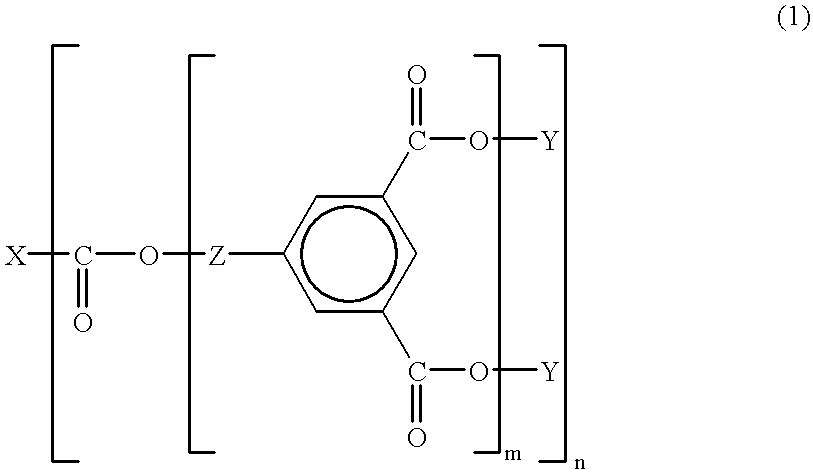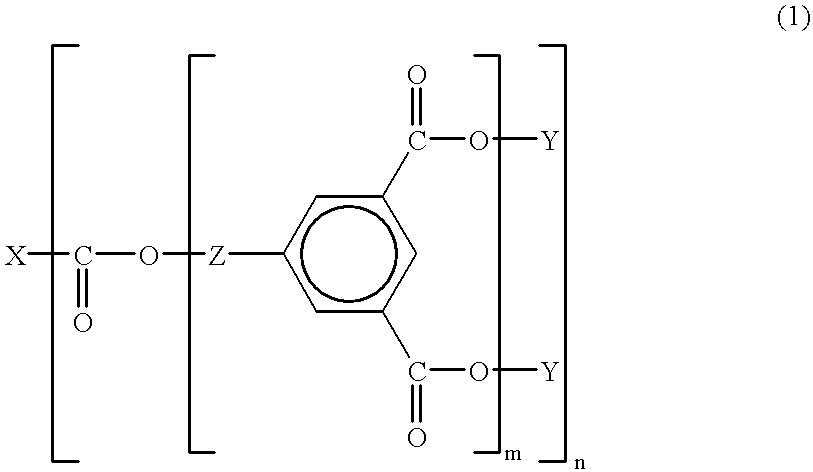Aromatic ester (meth)acrylate dendrimers and curable resin composition
Inactive Publication Date: 2001-07-03
NIPPON STEEL AND SUMIKIN CHEMICAL CO LTD
View PDF4 Cites 8 Cited by
- Summary
- Abstract
- Description
- Claims
- Application Information
AI Technical Summary
Problems solved by technology
The monomers used in this manner, however, have a low density of functional groups per molecule and lower the crosslinking density after curing and, furthermore, the residual monomers remaining unreacted in the coating film after curing degrade the mechanical and thermal properties of the film.
In addition, the use of monomeric components and organic solvents is a disadvantage during work on account of odor and, in particular, the use of organic solvents is not necessarily a desirable method for controlling the viscosity because of a growing tendency to avoid it from the standpoint of reducing the release of volatile components.
The use of liquid polyfunctional monomers is another approach to solve the aforementioned problems, but the effect which the monomers of this type produce for lowering the viscosity is no more pronounced than that of monomeric components and organic solvents and, furthermore, the polyfunctionality tends to cause the coating film to undergo large shrinkage after curing and has made it difficult to obtain satisfactory results in respect to the properties of coated films, particularly long-term reliability at high temperature and high humidity.
Where n exceeds 6, branched molecular chains tend to become crowded together and, also undesirably, the degree of branching does not increase under the influence of steric hindrance.
With less than 5 parts by weight of the initiator, the extent of polymerization declines markedly which makes it difficult to form good coating films.
On the other hand, where the initiator is added in excess of 20 parts by weight, a large amount of the unreacted or decomposed initiator remains in the coating film.
Incorporation of less than 20 parts by weight undesirably leads to lowered crosslinking density and, in turn, to lowered surface hardness.
On the other hand, incorporation in excess of 500 parts by weight undesirably leads to a too high crosslinking density and develops a tendency toward formation of fragile coating films.
However, the majority of these nonpolymerizable diluents must evaporate in drying by heat in the course of curing.
The diluents, if remaining in large quantities, often cause serious defects in the surface hardness and adhesion of the coating films.
Method used
the structure of the environmentally friendly knitted fabric provided by the present invention; figure 2 Flow chart of the yarn wrapping machine for environmentally friendly knitted fabrics and storage devices; image 3 Is the parameter map of the yarn covering machine
View moreImage
Smart Image Click on the blue labels to locate them in the text.
Smart ImageViewing Examples
Examples
Experimental program
Comparison scheme
Effect test
examples 1 to 12
Curable resin compositions relating to Examples 1 to 12 were formulated from 50 g each of aromatic ester acrylate dendrimers A to L obtained in the aforementioned Synthetic Examples 1 to 12, 30 g of dipentaerythritol hexaacrylate (hereinafter abbreviated to DPHA), 20 g of tetrahydrofurfuryl acrylate (hereinafter abbreviated to THF-A), and 5 g of a polymerization initiator (Irgacure 1700, product of Ciba-Geigy).
the structure of the environmentally friendly knitted fabric provided by the present invention; figure 2 Flow chart of the yarn wrapping machine for environmentally friendly knitted fabrics and storage devices; image 3 Is the parameter map of the yarn covering machine
Login to view more PUM
| Property | Measurement | Unit |
|---|---|---|
| Composition | aaaaa | aaaaa |
| Viscosity | aaaaa | aaaaa |
| Electrical resistance | aaaaa | aaaaa |
Login to view more
Abstract
This invention relates to an aromatic ester (meth)acrylate dendrimer composed of the core formed by an aromatic polycarboxylic acid and the branches formed by an aromatic compound containing one hydroxyl group and two carboxyl groups and represented by the following general formula (1)and also to a curable resin composition which contains the dendrimer and a polymerization initiator as essential components, is low in viscosity and highly curable, and forms a coating film with excellent heat and moisture resistance.
Description
FIELD OF TECHNOLOGYThis invention relates to aromatic ester (meth)acrylate dendrimers of highly branched structure and curable resin compositions containing said dendrimers as essential component.BACKGROUND TECHNOLOGYCurable resin compositions are generally used in coatings, adhesives, and molding materials because of their thermal and mechanical properties. These curable resins are mainly composed of oligomers and monomers and their concrete examples are epoxy acrylates, urethane acrylates, ester acrylates, and unsaturated polyesters. Of these compounds, particularly the oligomeric components exert a great influence on the properties of the coating films to be formed after curing or those of the molded articles and, in consequence, the properties of the oligomeric components assume great importance for manifestation of good material performance. These compounds generally have a linear molecular structure and tend to increase in voscosity and become highly viscous as their molecular...
Claims
the structure of the environmentally friendly knitted fabric provided by the present invention; figure 2 Flow chart of the yarn wrapping machine for environmentally friendly knitted fabrics and storage devices; image 3 Is the parameter map of the yarn covering machine
Login to view more Application Information
Patent Timeline
 Login to view more
Login to view more IPC IPC(8): C07C69/00C07C69/76C07C69/90C08F22/00C09J151/00C08L51/00C08F22/10C08G83/00C09D151/00C09D4/00C07C69/80C08F290/06C08F299/04
CPCC07C69/76C07C69/90C08F22/10C08F22/105C08G83/003C08L51/003C09J151/003C09D4/00C09D151/003C08F222/1006C08F22/1006C08F222/103
Inventor YUASA, MASATOSHIKAWASATO, HIRONOBUTERAMOTO, TAKERO
Owner NIPPON STEEL AND SUMIKIN CHEMICAL CO LTD
Who we serve
- R&D Engineer
- R&D Manager
- IP Professional
Why Eureka
- Industry Leading Data Capabilities
- Powerful AI technology
- Patent DNA Extraction
Social media
Try Eureka
Browse by: Latest US Patents, China's latest patents, Technical Efficacy Thesaurus, Application Domain, Technology Topic.
© 2024 PatSnap. All rights reserved.Legal|Privacy policy|Modern Slavery Act Transparency Statement|Sitemap



